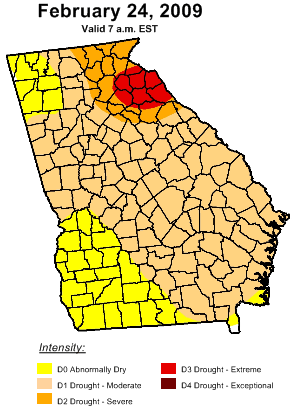Is the North Georgia Drought Finally Over?
Thursday, May 7th, 2009Compared to the past few years, the weather this spring in North Georgia has been wet. Virtually the entire state reported above-normal rainfall in April, which followed a wetter than normal March.
Some unofficial reports of rainfall totals in April were over ten inches in South Georgia, while the highest official total was 7.3 inches in Alma, over four inches above normal. Atlanta was 1.56 inches above normal for April, and Athens had 1.12 inches above normal precipitation.
May has gotten off to a wet start as well. As of May 6th, Atlanta had recorded 2.05 inches of rain, which is 1.31 inches above normal for the first week in May. With this morning’s storms and chances of more wet weather still ahead through the weekend, we are close to reaching the 2.8 inches of precipitation recorded for all of May, 2008, and will have more May rain than since at least 2004. Normal May rainfall in Atlanta is 3.95 inches for the entire month.
Lake Lanier continues to fill as well. The lake level is at 1064.95 feet at Buford Dam, 7 inches above where it was when the current rains started a week ago, and just six feet below full pool.
The latest drought outlook from the Climate Prediction Center says,
Several inches of precipitation are forecast in the short-term for the last vestiges of the once expansive drought that covered the interior Southeast. Given the expected heavy precipitation through the forthcoming weekend, and nothing indicating enhanced probabilities for significantly below-normal rainfall through the end of July, it seems likely that we will finally be able to close the books on this protracted and at one time serious, large-scale drought that has been affecting the Southeast for the last 3 years.
And, State Climatologist David Stooksbury reported earlier this week that conditions on Lakes Lanier and Hartwell have improved to mild drought from moderate drought because of the increasing lake levels. The rest of the state is drought free. He reports above normal soil moisture for most of the state, and normal to above normal stream flows. He says,
Sphere: Related ContentMay is typically one of the drier months in Georgia. Additionally, with high temperatures routinely in the 80s and plant water use very high, moisture loss is accelerated. We normally expect the soils to start to dry out this month.
As we progress through the summer into the middle of fall, moisture loss from the soil – due to evaporation and plant use – is normally greater than rainfall. With normal weather over the next several months, Georgians can expect to see a drying of the soils. However, this is normal and does not mean that Georgia is heading back into a drought.


 As far as the weather goes, winter is almost over, and with it, the best chance for reducing Georgia’s long-term drought. However, looking at the rainfall we’ve had for the first two months of the year, we are woefully behind where we should be. As of this morning, we’ve had 4.39 inches of rain in Lawrenceville, compared to a normal of 9.19 inches, or 48%. Atlanta is doing even worse, with only 3.84 inches, or 42% of normal rainfall.
As far as the weather goes, winter is almost over, and with it, the best chance for reducing Georgia’s long-term drought. However, looking at the rainfall we’ve had for the first two months of the year, we are woefully behind where we should be. As of this morning, we’ve had 4.39 inches of rain in Lawrenceville, compared to a normal of 9.19 inches, or 48%. Atlanta is doing even worse, with only 3.84 inches, or 42% of normal rainfall.